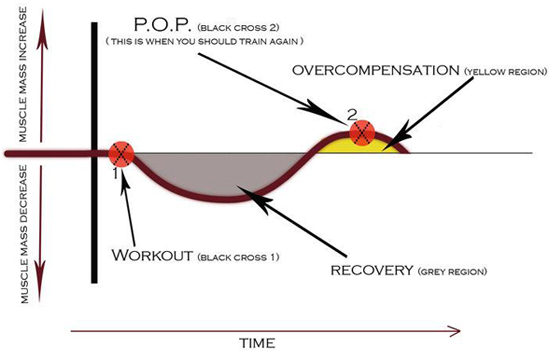 My most asked question come spring time is… “Mark, how can I get a six pack?”
My most asked question come spring time is… “Mark, how can I get a six pack?”
The short answer is that it’s a combo of diet and bodybuilding workouts that leads to success. NOT insane amounts of cardio and crunches.
Abs are built in the kitchen – so you NEED to cut.
And, if you’re on a cut and want to get a six pack, you should do LESS weight training, not more.
Shocked!? Let me explain…
The goal when cutting is not to change your workouts to something that makes the body become more “toned” and defined in 1 step. Why not? Because there’s no such thing.
Your weight training doesn’t change just because you’re cutting. High reps won’t help, shorter rest periods won’t help; nothing really gets you cut apart from diet. Fact.
Remember this:
The goal when cutting is to seek to continue to add muscle mass (or at least preserve it) with anabolic-type training, while taking care of fat loss with diet (and possibly a little bit of cardio).
This leads to the “toned”, “ripped”, or “defined” look. It’s a 2 step process:
- Continue to train bodybuilding style
- Torch fat with diet
There is no special type of training that leads directly to this look. It’s muscle-building training combined with diet that gets results.
Now…I said above that there is 1 thing that SHOULD change.
And that is the amount or VOLUME of your training.
It should actually decrease. Why?
It all goes back to a phrase I coined a few years ago – ‘Peak Overcompensation Point‘ (POP).
What is POP? Take a look at this diagram, which features in the free THT book. Bear in mind that recovery and growth/overcompensation takes place in the rest periods after workouts. The workout itself merely STIMULATES this process into action.

POP can be defined as…
the period of time it takes for your workout to produce MAXIMAL GROWTH and BEFORE the muscle starts to ATROPHY (get smaller) again.
When cutting your nutritive equilibrium will have shifted, i.e. you’re in a caloric deficit and eating below maintenance energy requirements much of the time.
This has the effect of prolonging your POP as you simply cannot recover and grow as quickly in a calorie deficit environment.
You could take the approach of taking longer lay-offs between workouts to compensate for this, but a much better method is to REDUCE the volume of work completed in order to ensure that your recovery/growth time does NOT increase.
However, you will still work to the same level of INTENSITY. Intensity never changes; you’ll simply complete less sets per workout.
The result is that we can CONTINUE to make progress in the gym week after week while in a calorie deficit.
This is in stark contrast to most people who go on a cut and lose massive amounts of strength and muscle tissue along with body fat. Unfortunately, many of these people then think there is something wrong with them, rather than with the inferior plan they are using. They conclude that they just won’t ever have a six-pack 🙁 .
TSPA‘ers constantly report continuing strength gains all throughout the program (along with not really feeling that hungry due to the nutritional design and set-up).
If you want to get ripped using shorter training sessions, just a little bit of cardio (or none), preserve your muscle, look great, and eat bacon cheeseburgers, go for Total Six Pack Abs.
On the other hand, if you want to ignore the FACTS and try to get muscular and lean by doing poorly designed, catabolic, über-aerobic, ridiculous programs that will end up leaving you looking like someone dying of starvation, go for “Insanity” or P90X.
And this isn’t a sales pitch. If you don’t buy my program or anyone else’s, at least take this advice:
![]() Train with the same intensity but reduce the volume of sets
Train with the same intensity but reduce the volume of sets
![]() Create a caloric deficit while still getting your daily protein needs
Create a caloric deficit while still getting your daily protein needs
![]() Add a little cardio into the mix, but only after a few weeks as a booster. You can’t go gung ho with diet and exercise from day 1 when cutting because you’ll soon damage your metabolism and stall – hard! This is the situation experienced by those who starve themselves and start cardio from day 1 only to stop losing fat after a few weeks despite their best efforts.
Add a little cardio into the mix, but only after a few weeks as a booster. You can’t go gung ho with diet and exercise from day 1 when cutting because you’ll soon damage your metabolism and stall – hard! This is the situation experienced by those who starve themselves and start cardio from day 1 only to stop losing fat after a few weeks despite their best efforts.
Cut the right way!
Your buddy,
Mark

Great article…and I felt like I should post because I wanted anyone who stumbled through here to understand how (A) This article isn’t a lie or marketing (though it being completely true is a huge marketing plus) and (B) to let people know that the TSPA program absolutely works.
I’m staring my second run on it now (2 weeks in) because I let myself go a bit over the winter (parties, holidays, drinking, etc…hey, I can let it loose cuz I now have a guaranteed system to get to 10% bf).
People (my girlfriend and her friends) think that doing 2 hour cardio sessions, yoga, running miles, etc…is the way to getting back in shape and think I’m nuts. But read Mark’s books and his posts. The science is undeniable.
Love the site Mark, and thanks for making shit so easy for all of us.
Question: When does muscle atrophy start to occur? I believe you mentioned in one of your other articles that it takes about two weeks (which is why it’s still okay to take a “rest week” every 9-12 weeks). I imagine it’s a little different for everyone, but can you clarify when atrophy starts to occur?
Excellent article, Mark. Getting cut is one of the things people -including me- do wrongfully. Tons of aerobic (often called cardio by many), high-rep sets, starvation diets, and much other non-sense people copy from other people at the gym or from crap they hear somewhere else.
The part where you mention cutting down on workout volume was a real eye opener for me.
Thank you for bringing sanity into the equation, and keep up the great work!
I thought we weren’t supposed to cut at all, but just keep to a good diet and training programme. I’m sure that’s what you’ve said elsewhere?
I’ve been trying to follow the GLAD diet – my work schedule is too erratic for MANS. I’m a naturally thin and toned guy with an overall low body fat (10%), but still have a small fat pad over my abs that I’m trying to shift. I’ve reduced my carbs further (daily GL well below 90) and have just started using BCAA’s for the first time, as this is meant to help prevent catabolism while on a low carb diet. Do you think this is a good plan?
The “no cardio” thing works (for hard gainers, at least). I live in NYC though, so I do a lot of walking (maybe 30-45 minutes per day… when I walk the dog, etc.), but that’s the extent of it. No high intensity stuff. My weight-training is pretty intense though. 😉
Thanks Mark!
A well researched and thought out article!
When you hit that ‘sweet spot’ where you are gradually losing fat and also getting stronger and bigger (more muscular) there’s no better feeling. And the way you describe is the best way to achieve this without crashing and actually harming your metabolism!
Regards, Graham
Basically the deal is, to see abb muscles the rule is one must have a body composition of 10% or less body fat, if your fat is higher you will likely not see the abb muscles, that’s if one has any significant muscles down there.
In short it takes a hardcore diet as well as hardcore cardio to Lean up, but you also have to build the abb muscles and the lower abbs are the toughest to engage by far, and ohh by the way the cute little abb crunch machines at the gym, well those are insignificant at best to build muscle, it takes hard work!!! Don’t be discouraged and good luck!
I agree too. The site is great and Mark’s books are great too. Lots of good information that works.
I am a vegeterian and want to build muscel so please give me protine diet plan for building muscles loss fatt
@ Jase – Dude, you don’t have to do hardcore cardio. It’s what Mark’s book is all about. If your diet is dialed in (as he explains in detail for ease of calculating macros) then the cardio can be few and far between (although High intensity bursts of course). And yah, doing hundreds of crunches and using the “ab machine” is pointless alone…but it, in conjunction with a serious eating plan and lifestyle solves the “mysterious puzzle” behind losing bodyfat.
Hardcore cardio, as explained in the article above, is just as likely to destroy your muscle as it is fat, hence, creating a zero-sum gain.
@ Rick
No disrespect, but to maintain a 7% body fat most body types cant do it with out cardio, is a Pipe dream for most, and as you age it becomes more difficult, if your 20 years old and have one hell of a metabolism its possible
As far as the weight room is concerned, I hit it everyday, it takes longer to build muscle at 7% but I’m very happy with what I have accomplished in that last 4 years.